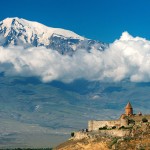By Staff, Paleontological Research Corporation

In 2010, the Hong Kong organization Noah’s Ark Ministries International or NAMI announced they had discovered the legendary vessel on Mount Ararat in eastern Turkey and were subsequently accused of perpetrating a hoax. Now, a professional archaeologist states there is significant merit to their discovery.
Harvard University educated archaeologist and director of the Paleontological Research Corporation, Dr. Joel Klenck, surveyed the site, analyzed the archaeological remains and completed a comparative study. “The site is remarkable”, states Klenck, “and comprises a large all-wood structure with an archaeological assemblage that appears to be mostly from the Late Epipaleolithic Period.” These assemblages at other sites in the Near East have calibrated radiocarbon dates between 13,100 and 9,600 B.C. Located at elevations above 4,200 meters on Mount Ararat and covered by layers of ice and stones, he states: “The site is wonderfully preserved, exhibits a wide array of plant materials including structures made of cypress and one room with a floor covered by chickpea seeds.” Klenck additionally notes, “I was most impressed by the artifactual assemblage, particularly the basalt bowls, stone cores and debitage.”
It also appears that the site was visited in later periods. Two small ceramic bowls from the Chalcolithic (5,800-3,000 B.C.) and Bronze Age (3,000-1,200 B.C.) periods were placed in one of the rooms of the structure. He adds, “These artifacts most likely represent brief later visits to the site since these bowls differ from the Epipaleolithic remains that comprise nearly all of the assemblage.”
Klenck reports, “The surface scatter of the wood above the large structure is 121.1 meters in length and 23.8 meters in width. The construction is at least 5.2 meters deep and several measurements of the exterior walls exhibit angles moving inward toward the base of the edifice. Also, there are stair-like features that descend through the middle of the multi-storied structure and mortise-and-tenon construction.” He remarks, “That this large wood structure is located on Mount Ararat, with what appears to be a mostly Epipaleolithic assemblage, is noteworthy.”
“The site is no hoax,” Klenck states, “and the size and excellent preservation of the edifice will enable it to be studied by numerous scholars.” He notes, “The large wood structure is buried under tons of stones and ice and most of the edifice remains unexplored.”
Regarding the initial carbon dating of the site at 4,800 B.C. by NAMI, Klenck states the initial discovery team comprised people with limited archaeological experience. He remarks, “Instead of obtaining samples from cores and unexposed locales and wrapping them in tin-foil, surface samples were retrieved with bare hands or cotton gloves. The date most likely reflects a sample that was contaminated by ancient visitors or modern explorers to the site. Most of the assemblage portrays a much earlier period.” He notes that all future radiocarbon samples should be delivered to archaeology departments at Istanbul University that will date the artifacts or send the samples to archaeometry facilities at the University of Berlin.
He also notes that a nearby cave exhibits artifacts similar to those in the large wood structure. Klenck states the cave site possesses botanical remains of chickpea, flax fibers and rope, pieces of fabric, bone artifacts, and vessels made of an organic material. He adds, “In both the large wood structure and cave, most of the bowls are made of an organic material, perhaps animal stomachs, and the flaps are folded over wood or bone collars. Several of these bowls resemble early ceramic types from the subsequent Pottery Neolithic Period (6,400-5,800 B.C.).” Klenck opines, “These artifacts prompt questions if bowls made from organic materials influenced the first pottery styles.”
“These sites are extremely important for archaeologists and conservators,” states Klenck, “particularly with regard to the preservation of wood and plant materials and the examination of architectural features. He is emphatic that the Antiquities Authority of Turkey needs to protect the research area and allow only approved archaeologists and conservators to visit the sites. “These precautions must be completed”, remarks Klenck, “to prevent adventurers and local mountain guides from breaking off pieces of wood and removing artifacts from the research area.”
.
He states the initial skepticism of the archaeological community is understandable but will fade as more researchers and conservators complete their analyses and publish reports in scientific journals. Klenck adds, “Here, the evidence is wide ranging. Also, very little of the structure is surveyed and much of the site is inaccessible being covered or blocked by ice.”
The discoveries on Mount Ararat coincide with academic discussions on the transition between the Pleistocene and Holocene epochs during the Younger Dryas stadial (10,900-9,500 B.C.) and the beginning of the Pre-Pottery Neolithic Period, around 9,600 B.C., where the first village communities in southeastern Turkey became associated with intensive agriculture and plant and animal domestication. Klenck states, “Some scholars see this transition period as cataclysmic with dramatic increases in sea-levels, flooding, animal extinctions, and decreases in human populations; others assert this phase was simply a cold, dry period evidenced by sparse vegetation.” “In the midst of this debate,” he notes, “there is a large all-wood structure and a cave, with artifacts resembling an Epipaleolithic assemblage, at a high elevation on Mount Ararat.” Klenck concludes: “The Ararat sites are very special because of their preservation and unique insight into the prehistoric past.”
Joel Klenck is director of research for the Paleontological Research Corporation.
Copyright © Acts News Network, Inc.
